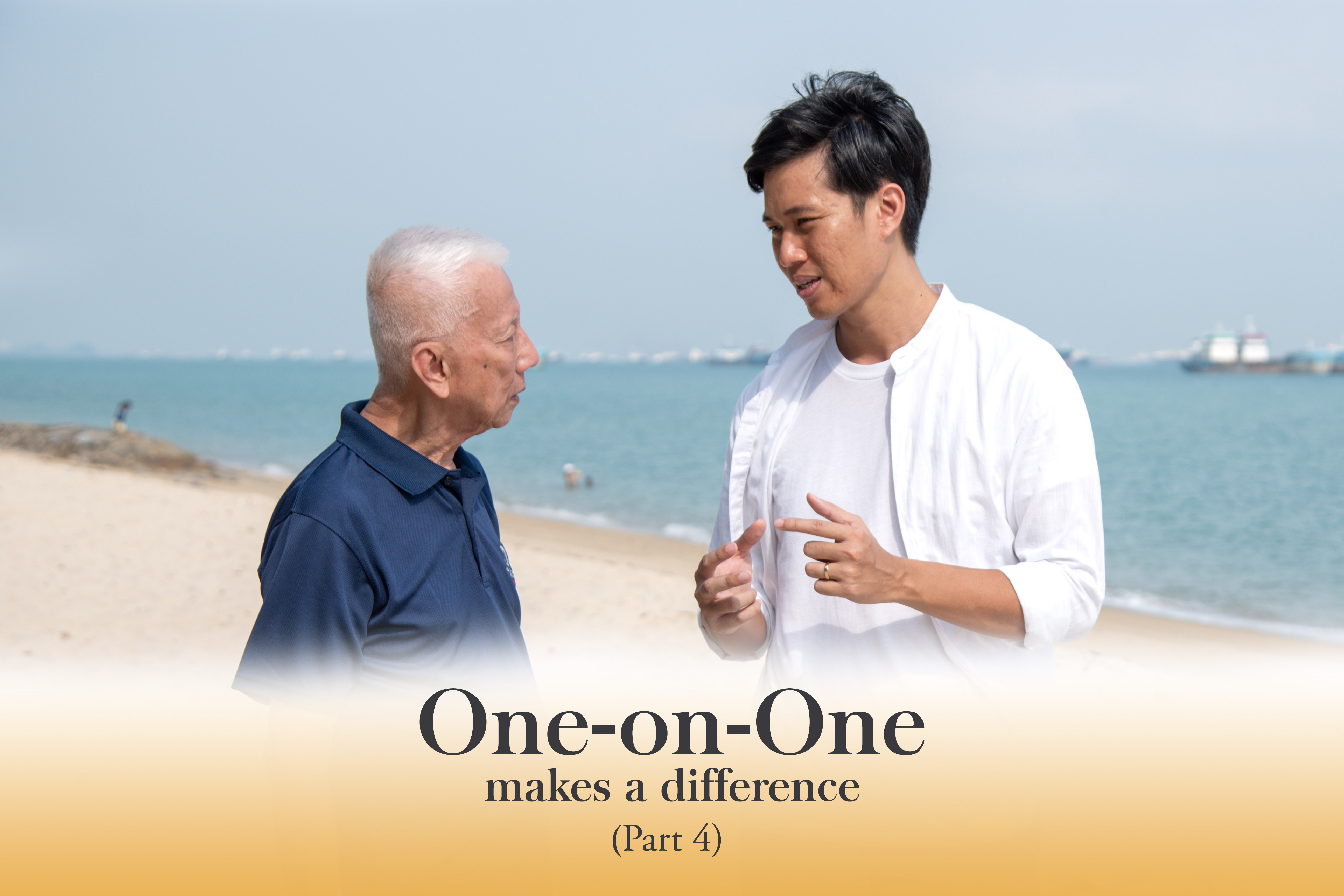One-on-One Makes a Difference — Part 4
Former National Director and Senior Mentor of The Navigators Singapore

(Click here for Part 3)
Mentoring and Man-to-Man
“And the things which you have heard me say in the presence of many witnesses,
entrust to faithful men who will be able to teach others also.” (2 Timothy 2:2)
Paul Instructed and Impacted Timothy
When I initially encountered the concept of mentoring another person one-on-one, I was captivated by its appeal.
Paul, in his teachings to Timothy, instructed him to pass on the knowledge to others—a chain of influence where one person imparts wisdom to another, who then, in turn, is empowered to do the same for others. As my faith matured, the principles that became deeply ingrained in my life were instilled through the examples set by those who influenced me. The impact on my life came not just from accumulating notes in my files from seminars and conferences, but more profoundly from the personal influence of individuals who exemplified their beliefs before my eyes — people who walked the talk.
Jesus Invested His Life in His Disciples
Jesus' ministry, which lasted for a brief three and a half years, was strategically centred on His disciples. While there was some public outreach, the majority of His focus was dedicated to unravelling the profound aspects of the Kingdom of God to His disciples and guiding them toward a deeper faith in Him. Jesus deemed it appropriate to entrust the crucial task of conveying His mission—providing a way back to the Father through His death on the cross—to a group of ordinary men.
By the time He concluded His time with them, empowered by the Holy Spirit, these once ordinary men had transformed into extraordinary individuals. Jesus reshaped the trajectory of their lives through His intimate relationship with them.
The Vital Influence of One Person on Another
Dawson Trotman, the founder of The Navigators, was an ardent believer in the potential of each individual’s influence on another. Once, he led a policeman to Christ. The sailor who was with Dawson witnessed the entire transformation and said, "Boy, I would give my left hand to be able to do what you just did!"
It cost Les Spencer more than his left hand; it took his whole life. By the time World War II ended, there was a ministry on board every ship in the US Navy, influenced by sailors like Les and others who engaged in one-on-one mentoring, multiplying the impact of discipling and disciplemaking through faithful men.
Resurgence of the Impartation of Man-to-Man by Older Ones
In an earlier era, from the 1960s-1980s, the practice of one-on-one discipleship was more prevalent among the Navigators. This practice subsequently declined and there was a proliferation of seminars and conferences instead.
There is a danger that what was once taught and modelled by an ardent believer seeking to impact a younger one is now overshadowed by group teaching through lectures. This has resulted in the loss of the art of disciplemaking through a personal, one-on-one process.
Today, there is a growing return to this simple but vital process. Those reaching out to others individually are fulfilling the call of obedience to the Great Commission.
Mid-Lifers Wanting to End Well Chose Man-to-Man
Interestingly, many middle-aged individuals, upon evaluating their life's involvement, express a desire to finish their lives well. They recognise the importance of contributing to the process of building up the lives of others through one-on-one interactions. Similar to the process where an experienced fisherman coaches and imparts years of knowledge and skill to a rookie young fisherman, this is done individually—guiding and imparting skills through nurturing, training, and genuine concern.
There is an even greater motivation to help train and guide other younger Christians, encouraging them to commit themselves to respond to the call of the Great Commission in training and raising labourers for the harvest.
Temptation to Jump-start by Teaching a Class
There is always the temptation to jump-start the process of imparting and impacting the next generation by teaching a class. It is the very real modus operandi of our times. Packaging anything that seems to work with a few ideas and a pretty presentation sells virtually anything.
But in the process of changing lives and drawing them to the Lord and His work, there is no shortcut. Disciplemaking cannot be manufactured en masse with a cookie-cutter approach like making gingerbread men cookies. It is still done the old-fashioned way, one at a time.
How does the Process of Man-to-Man begin?
When a young man apprentices to a master craftsman at the beginning of his attachment, he does not approach the master and say, “Teach me to do what you can do and do it quickly.” It is a process that involves building a relationship and includes modelling, where the apprentice observes and imitates the master.
The expression, “more is caught than taught,” is especially true in this context. Even if the basic skills are taught and imparted, there remains a distinction in the craftsmanship. The true master craftsman not only practises his skill, but one can also sense his spirit, passion, and emotions in the final product.
Therefore, we do well to pay heed to godly models, especially those whose lives are set apart to serve the Lord with dedicated passion, and their ultimate goal of disciplemaking is to follow the only Master, the Lord Jesus Christ.
Learning Discipleship through Man-to-Man
The root word of “disciple” is "learner," signifying one who seeks knowledge. To understand the path of Christian fellowship, specifically the practice of following Christ, it is best achieved by imitating the example of another.
Herein lies the dilemma: Who is capable of being that example? Who dares to teach another how to do it?
Due to a lack of labourers, there is a scarcity of disciples.
There are no role models; everyone is deflecting the leadership responsibility to the pastor. But is the pastor the best role model? In reality, the pastor may not be an ideal representation of an average person.
Our aspiration is for the average person to follow Christ, becoming a model for others by imitation. This allows others to ask questions and seek guidance on the "how."
The only way to address this is to learn how to do it in the first place. The challenge of discipleship and disciplemaking through one-on-one interactions is daunting but deeply satisfying. The outcome of such a process is someone who is ready to pass it on.
Character Moulding is Harder than Teaching
In the practice of man-to-man, inevitably, two individuals may rub each other the wrong way. Punctuality, keeping one's word, and tardy responses are some behaviours that could lead to differences and conflicts.
Unfortunately, there are few who would even bother to help correct the flaws and kinks in our character armour. Who dares? Who bothers? Man-to-man interactions allow for flaws to be examined up close.
Rebuke and correction, as outlined in 2 Timothy 3:16, are the primary focus of the use of the Word of God. How it is practised and taught will have a significant impact on the future actions carried out by subsequent generations of disciples.
Jesus’ Method of Training His Disciples — Man to Man
Jesus chose the arduous process of teaching and correcting his disciples at a personal level. The numerous instances where Peter was corrected and taught by Jesus reflected His approach to training. Peter was reinstated after denying Jesus, through a special personal session of affirmation and encouragement.
In his subsequent writings in 1 and 2 Peter, the once tempestuous Peter speaks with mellowness about the acceptance of suffering for the Lord’s sake. Having once advocated immediate action, he now teaches gentleness in dealing with others, even in the aspect of outreach (1 Peter 3:15) and in restoring younger individuals (1 Peter 5:1).
One-on-one interaction is evident in the way Jesus handled the Samaritan woman (John 4), the blind man (John 9), and numerous other accounts. Each individual is important, and Jesus demonstrated this by spending time with each person, one at a time.
Ask God for Someone Who Would Do the Same
There is no greater satisfaction than praying and witnessing the Lord bring someone into your life so that you can follow the example of Christ—investing time in another person on a one-on-one basis.
While not everyone may feel comfortable teaching a class, everyone is capable of influencing another person individually. The skill and practice of one-on-one interactions come with simply doing it more often. The dividends and rewards of helping someone grow through this approach are among the least discovered secrets of the Christian faith and yet are the ones that truly please the Lord.
Over time, a pertinent question may arise: “Have you invested time one-on-one in the life of another?” This answer is often neglected by many because few are willing to take up the challenge and responsibilities outlined in Matthew 9:35-37—raising labourers for the Lord's harvest. Yet it can be accomplished and realised if only we are willing to start with someone on a one-on-one basis!
(Click here for Part 5)



